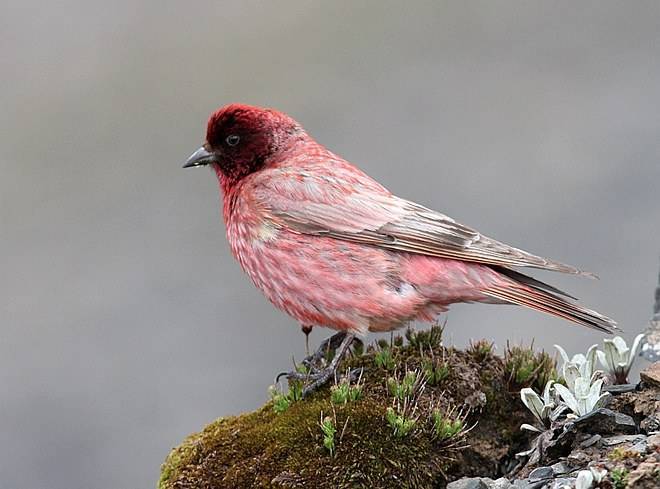Carpodacus roborowskii
IUCN
LCBasic Information
Scientific classification
- name:Carpodacus roborowskii
- Scientific Name:Carpodacus roborowskii,Tibetan Rosefinch,Tibetan Vermilion Bird, Tibetan Vermilion Bird
- Outline:Songbird
- Family:Passeriformes Passerines
Vital signs
- length:16-17cm
- Weight:No verification information
- lifetime:No verification information
Feature
The male bird has a deep red head with a bright glow, a dark red throat with white spots, a grayish white back, and rose-red feather tips on each feather, forming many stripes.
Distribution and Habitat
It is a species endemic to China. It is only distributed in Qinghai, in the Burhan Buda Mountains at the source of the Yellow River, the Buqing Mountains north of Zhaling Lake, and the Chuma River Basin.
The Tibetan sparrow inhabits the high mountain rocky slopes, grasslands, and plateau wilderness with scattered shrubs and sparse plants at altitudes above 4,000 meters and near the snow line on the Qinghai-Tibet Plateau.
Appearance
Male: forehead, front of the head, front of the eye, cheeks, eye area and side of the head are black-red, and the back of the head is also black-red but lighter and brighter. The back and shoulders are rose with light gray, and the waist and tail upper coverts are light rose. The tail is dark brown with rose feather edges, the wing upper coverts are light gray with a slight rose color and rose feather edges, and the large wing coverts have white tips. The flight feathers are brown-black, with narrow rose feather edges on the outer vanes, and white feather edges and tips on the inner flight feathers. The chin and throat are black-red with silver-white spots, and the rest of the lower body is rose with a slight purple color. The abdomen and undertail coverts are lighter and light rose, and the armpits and underwing coverts are white.
Female: The upper body is gray-brown with dark vertical stripes, the waist and undertail coverts have unclear or no vertical stripes, the upper tail cove
Details
Tibetan Rosefinch is a high mountain and plateau desert bird with no subspecies.

Tibetan Rosefinch is a resident bird. It moves alone or in pairs, and in autumn, it also moves and forages on the ground in family groups or small groups. It is good at running on the ground and rarely sings. It mainly feeds on seeds of alpine herbs, and also eats young leaves and shrub fruits and seeds.
The specimen of the Tibetan Sparrow was collected from the Burhan Buda Mountains in Qinghai, China. It has not been seen in many subsequent surveys. It is an extremely rare bird. On July 8-9, 1993, a group of Tibetan Sparrows, 3 males and 12 females, a total of 15 birds, were seen on a road at the junction of Qinghai and Tibet (5,200 meters above sea level). They were eating flowers of Pedicularus spp. on rocky wetlands. It is estimated that the Tibetan Sparrow may be distributed from Kekonor in Qinghai to the south to this Tanggula Mountain Road and all high places (Chikara Otani, 1995).
Listed in the IUCN Red List of Threatened Species in 2016 ver3.1-Least Concern (LC).
Listed in Appendix I, II and III of the Convention on International Trade in Endangered Species of Wild Fauna and Flora (CITES) 2019 edition Appendix II.
Listed in China's National List of Key Protected Wildlife (February 5, 2021) at level II.
Protect wildlife and eliminate game.
Maintaining ecological balance is everyone's responsibility!








